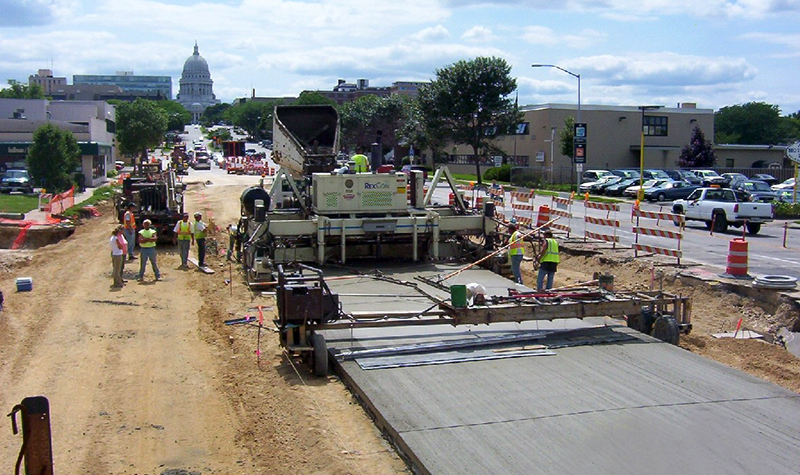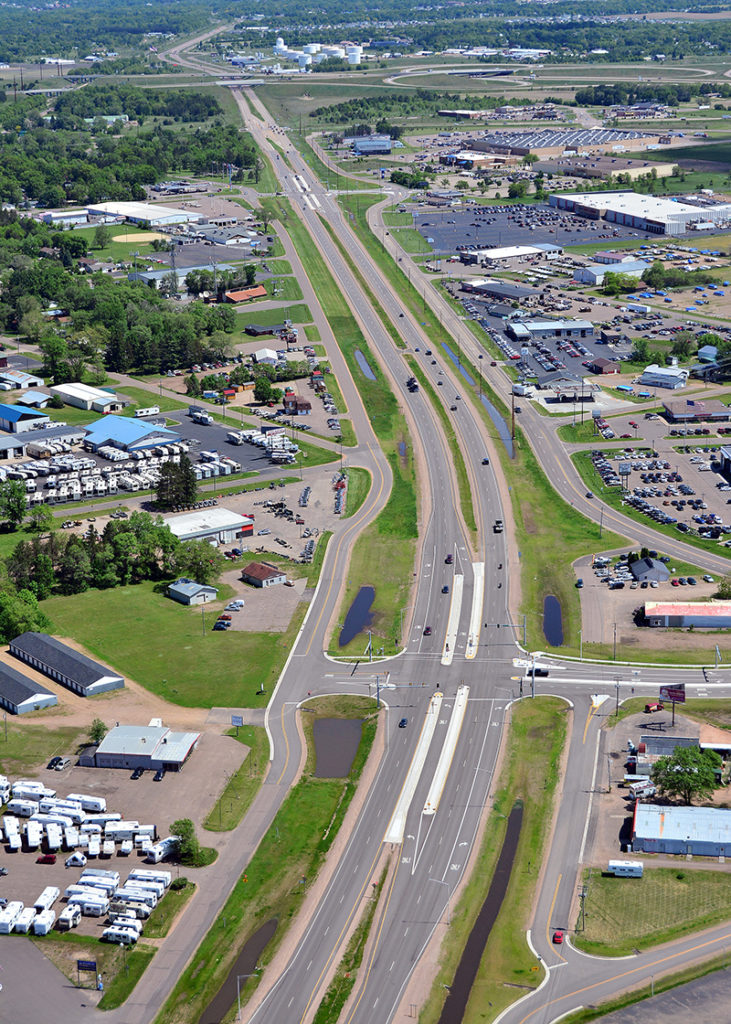Through or Around? Lots of Options for Accommodating Traffic During Construction

When it’s time for a community to reconstruct a busy street, visions of orange barrels cause foreheads to wrinkle reflexively. It can be hard to get from Point A to Point B when the road between them is closed or partially constricted by construction. Deciding how the project is handled boils down to this: Closing the street and detouring traffic gets the job done fastest and saves taxpayers the most money but poses the greatest disruption and cost for those located along the work zone. Allowing traffic to continue flowing on a street that’s under construction means the disruption will be less drastic but will last longer and add taxpayer costs.
When you give contractors all the room they need, they can spend their entire workday on the actual work. When contractors have to work on a project and then make
it temporarily drivable again, and then repeat that cycle over time, they spend only part of their shift moving the project forward. Much of their time is spent moving barrels and signage to redirect traffic as they alternate between digging into the project and making it passable for traffic again.
Working each night and keeping lanes open during the day is sometimes an option – although an expensive one. If a contractor needs to install/replace a pipe that is 10 feet under the street surface, they start their shift by removing the 10 feet of earth, excavating the trench, and installing a length or two of pipe. Then it’s time to temporarily seal off the unfinished end of the pipe to ensure it stays clean inside, followed by backfilling the hole and making the road ready for traffic to use again. Production in this scenario would be very slow and very costly.
Typically on a residential street or other lightly traveled roads, complete closure and detouring of traffic is practical and reduces construction costs and duration. But in the case of a busy arterial with two or three lanes of traffic in each direction, closure is not an option. Municipalities and their consultants must come up with detailed plans for shifting traffic to certain lanes so construction can continue in other lanes.
Traffic detours and staging: What are your options?
A municipality’s first step is to determine whether close-and-detour is feasible. Is a good detour route available that is convenient enough that the public will use it instead of cutting through residential areas or sneaking through the construction zone? Will closure be too devastating to businesses who will lose customers without alternate access?

If maintaining traffic on the street is critical, then a consultant searches for safe locations and proper temporary signage/signal solutions to direct traffic into a temporary lane during construction. If the project involves a long stretch of pavement, the necessary lane shifts may need to be set up for one segment for the earliest stage of construction and then shifted down the road – or across to the other side of the road – to accommodate subsequent construction stages. Ayres Associates was able to orchestrate construction staging on a rapidly developing segment of River Prairie Drive in Altoona, Wisconsin, bringing the four-lane road down to two lanes while construction proceeded on the other two lanes. Multiple lane shifts got the job done on a Business 53 project in Lake Hallie, Wisconsin. In the multi-stage, multi-year East Washington Avenue project in Madison, Wisconsin, Ayes Associates provided observation services for a six-lane reconstruction project that kept four lanes of traffic open to traffic during construction.
The curing time for concrete streets, sidewalks, driveways, and curb and gutter can be three to seven days. If this curing period threatens to cut off access to a business at a critical time, the contractor can leave a gap in the concrete to allow access. But this can double paving time if done extensively, as the crew has to stop operations, move equipment ahead, and restart the operations. This delays completion and can affect the ride quality and look of the finished pavement.
When closure is the only way
If closing the street is the only practical option, early consultation among businesses, other stakeholders, the municipality, and consultants helps to make the best of a difficult situation. Among the accommodations that are considered:
- Routes are designated for trucks to access businesses without using the closed street. If absolutely no alternate route exists for deliveries to certain businesses, a schedule is worked out to allow trucks to go through the construction zone at specific times.
- Alternate routes can even be critical in a residential area, where there might be small businesses such as daycare facilities or people who need oxygen deliveries and access for caregivers. Timing of critical traffic is communicated to contractors, who work around it.
- Safe pedestrian crossings and access to public transportation are also considered. In the East Washington project, a blind gentleman needed to cross the 56,000-vehicle-per-day street to reach a bus stop. Whenever traffic staging shifted how traffic flowed through the intersection where he crossed, a contractor or Ayres staffer would guide him across the new path.
- Early and frequent information campaigns and news releases with specifics about periodic traffic shifts tell customers how to reach businesses.
Sometimes maintaining access requires getting creative, including a construction project years ago on State Highway 100 in Milwaukee County that could not accommodate left turns during construction. A campaign called “Make the Right Turn” began about nine months before construction to tell residents they could get to businesses by making a series of right turns in place of a left turn.
That kind of early education gives business owners and the community a heads up. On Madison’s East Washington project, the City offered to put up Alternative Business Route signs so traffic would use side road access and back entrances to get to businesses. Maps were provided to businesses so they could copy them, post them, and hand them out to customers and delivery drivers.
Creative ways to maintain traffic to businesses
The Wisconsin Department of Transportation’s “In This Together” program gives businesses tips, case studies, and samples of promotions that have worked in various communities. Businesses sometimes meet up to two years ahead of a construction project, appoint block captains, lay the groundwork for weekly radio and newspaper updates, and set up email distribution lists. Chambers of Commerce and Main Street program directors often help get businesses involved.
WisDOT offers this checklist for businesses and employers looking to reduce construction zone bottlenecks:
- Stuff brochures about getting around during construction in employees’ paychecks and customers’ billings.
- Schedule shipments at nonpeak travel times.
- Encourage employees to use alternate transportation or company-sponsored carpooling.
- Investigate flextime or four-day workweeks to reduce employee travel during rush hours.
- Consider letting employees telecommute during construction.
Kim Ballweg, PE, has 25 years of experience in transportation design and construction. She supervises construction engineering for projects in southern Wisconsin. Along with her technical prowess comes her ability to communicate with all the players on a project to deliver construction traffic control, utility coordination, public involvement, constructability reviews, and overall project management.

Post a comment: